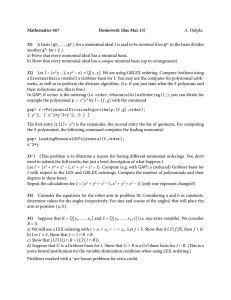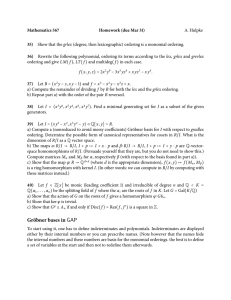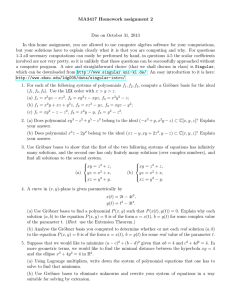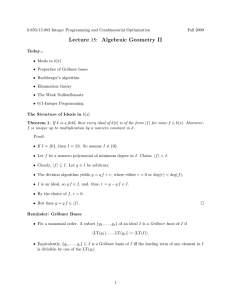Document 13449620
advertisement
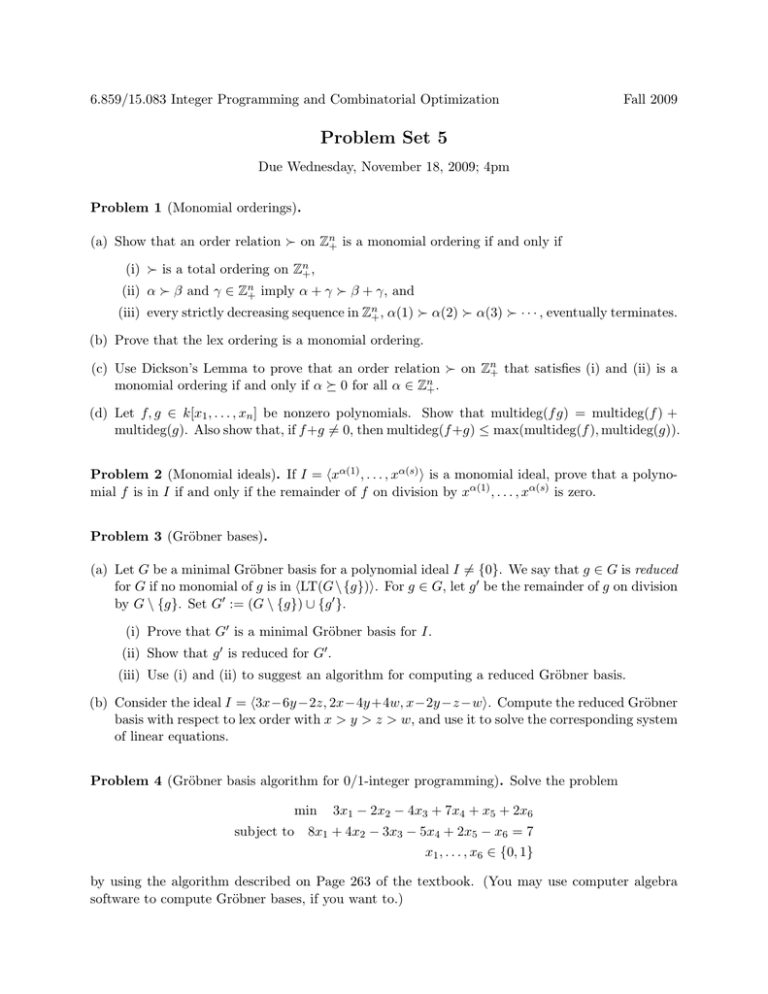
6.859/15.083 Integer Programming and Combinatorial Optimization
Fall 2009
Problem Set 5
Due Wednesday, November 18, 2009; 4pm
Problem 1 (Monomial orderings).
(a) Show that an order relation � on Zn+ is a monomial ordering if and only if
(i) � is a total ordering on Zn+ ,
(ii) α � β and γ ∈ Zn+ imply α + γ � β + γ, and
(iii) every strictly decreasing sequence in Zn+ , α(1) � α(2) � α(3) � · · · , eventually terminates.
(b) Prove that the lex ordering is a monomial ordering.
(c) Use Dickson’s Lemma to prove that an order relation � on Zn+ that satisfies (i) and (ii) is a
monomial ordering if and only if α � 0 for all α ∈ Zn+ .
(d) Let f, g ∈ k[x1 , . . . , xn ] be nonzero polynomials. Show that multideg(f g) = multideg(f ) +
� 0, then multideg(f +g) ≤ max(multideg(f ), multideg(g)).
multideg(g). Also show that, if f +g =
Problem 2 (Monomial ideals). If I = �xα(1) , . . . , xα(s) � is a monomial ideal, prove that a polyno­
mial f is in I if and only if the remainder of f on division by xα(1) , . . . , xα(s) is zero.
Problem 3 (Gröbner bases).
(a) Let G be a minimal Gröbner basis for a polynomial ideal I �= {0}. We say that g ∈ G is reduced
for G if no monomial of g is in �LT(G\ {g})�. For g ∈ G, let g � be the remainder of g on division
by G \ {g}. Set G� := (G \ {g}) ∪ {g � }.
(i) Prove that G� is a minimal Gröbner basis for I.
(ii) Show that g � is reduced for G� .
(iii) Use (i) and (ii) to suggest an algorithm for computing a reduced Gröbner basis.
(b) Consider the ideal I = �3x−6y −2z, 2x−4y +4w, x−2y −z −w�. Compute the reduced Gröbner
basis with respect to lex order with x > y > z > w, and use it to solve the corresponding system
of linear equations.
Problem 4 (Gröbner basis algorithm for 0/1-integer programming). Solve the problem
min
subject to
3x1 − 2x2 − 4x3 + 7x4 + x5 + 2x6
8x1 + 4x2 − 3x3 − 5x4 + 2x5 − x6 = 7
x1 , . . . , x6 ∈ {0, 1}
by using the algorithm described on Page 263 of the textbook. (You may use computer algebra
software to compute Gröbner bases, if you want to.)
Problem 5 (Total dual integrality).
(a) Consider the linear system
x1 + 2x2 ≤ 6,
2x1 + x2 ≤ 6,
x1 , x2 ≥ 0.
Show that it is not totally dual integral (TDI), yet it defines an integer polytope P . Find a
representation Ax ≤ b of P , with A and b integral, such that Ax ≤ b is TDI.
(b) Let Ax ≤ b be a rational system of linear inequalities. Show that there exists a positive integer
t such that 1t Ax ≤ 1t b is totally dual integral.
(c) Let G = (V, E) be a 2k-connected undirected graph.1 Orient the edges of G arbitrarily, yielding
the directed graph D = (V, A). Consider the following linear system:
�
�
xa −
xa ≤ |δ − (U )| − k for ∅ ⊂ U ⊂ V, 0 ≤ xa ≤ 1 for a ∈ A.
(1)
a∈δ − (U )
a∈δ + (U )
Here δ − (U ) (δ + (U )) denotes the set of arcs of D entering (leaving) U .
(i) Show that if (1) has an integral solution x, then G can be oriented so as to become a
k-connected digraph.2 (Hint: Reverse the orientation on the arcs of D with xa = 1.)
So it suffices to show that (1) has an integral solution to prove the following theorem:
A 2k-connected undirected graph can be oriented so as to become a k-connected di­
rected graph.
(ii) Show that (1) has a feasible (fractional) solution.
(iii) Show that (1) is TDI. (You may use the following fact: Let D = (V, A) be a digraph, and
let F ⊆ 2V be a family of subsets of V with the following property: if T, U ∈ F, then
T ⊆ U or U ⊆ T or T ∩ U = ∅ or T ∪ U = V . Then the matrix M with entries MU,a = +1
if a enters U , MU,a = −1 if a leaves U , and MU,a = 0 otherwise, for U ∈ F, a ∈ A, is
totally unimodular.)
1
2
An undirected graph is 2k-connected if each nonempty proper subset of vertices is entered by at least 2k edges.
A directed graph is k-connected if each nonempty proper subset of the vertices is entered by at least k arcs.
MIT OpenCourseWare
http://ocw.mit.edu
15.083J / 6.859J Integer Programming and Combinatorial Optimization
Fall 2009
For information about citing these materials or our Terms of Use, visit: http://ocw.mit.edu/terms.
